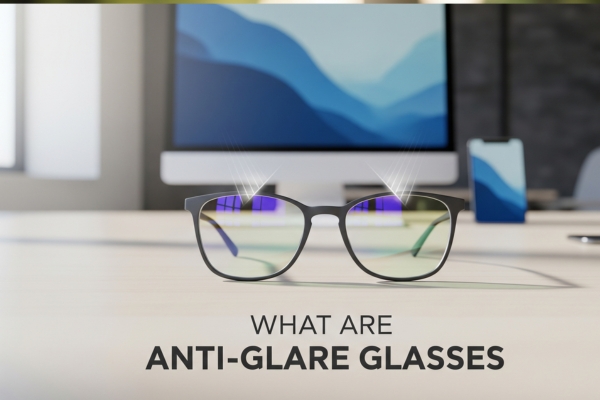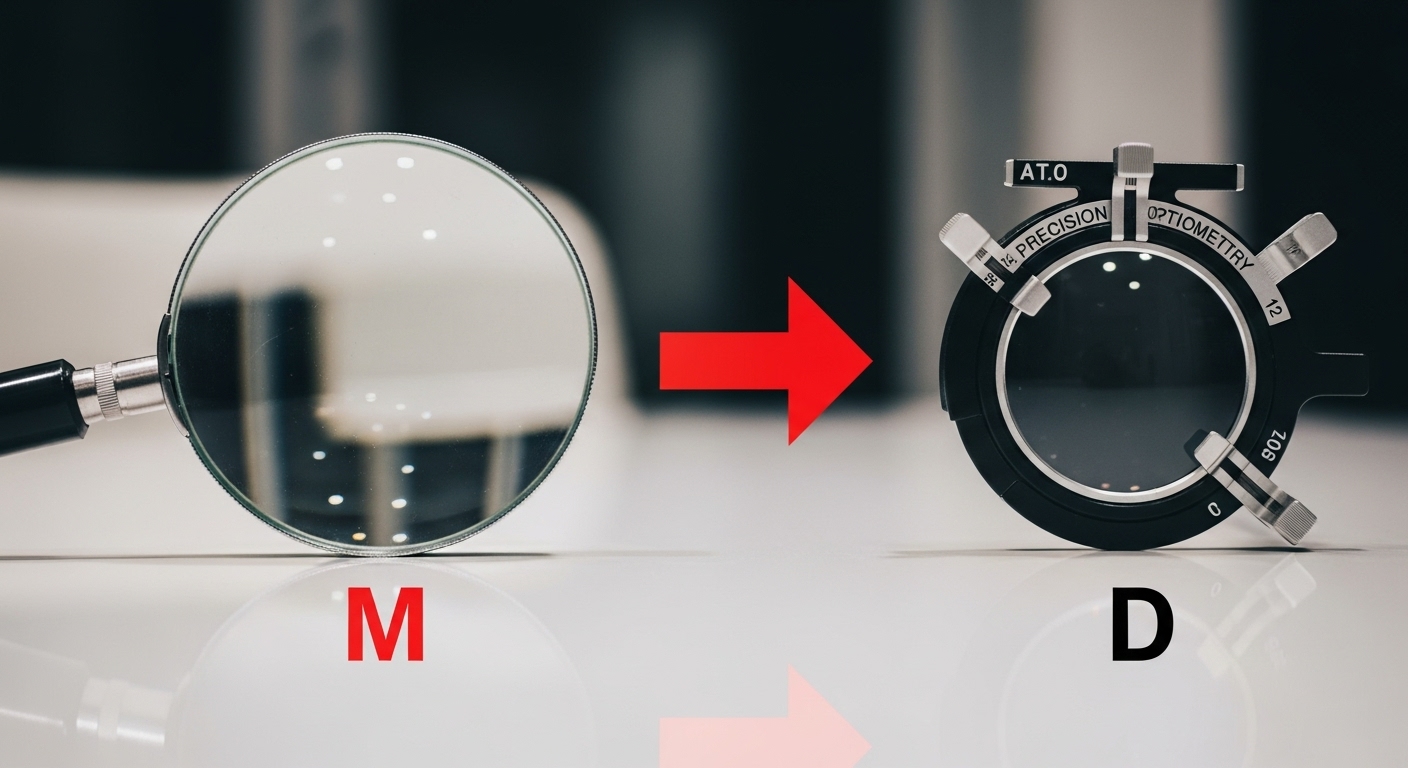



If you’ve ever struggled with annoying reflections on your glasses while driving at night or found yourself squinting at your computer screen, you’ve experienced exactly why anti-glare glasses were invented. I’ve spent years researching optical technologies, and anti-glare coatings represent one of the most practical advances in everyday eyewear.
Anti-glare glasses, also known as anti-reflective (AR) coated glasses, feature a special microscopic coating that reduces reflections from both the front and back surfaces of your lenses. This coating allows up to 99% of available light to pass through your lenses, compared to just 90% for uncoated lenses – a difference that significantly impacts your visual clarity and comfort throughout the day.
Recent research from PubMed and clinical studies have shown that over 60% of prescription glasses now include some form of anti-reflective coating, and 85% of users report improved visual comfort after switching to AR-coated lenses. But what exactly makes these coatings work, and are they worth the additional investment? Let’s explore the science, benefits, and practical considerations you need to know.
The technology behind anti-glare glasses involves applying multiple layers of metal oxides to the lens surface through a vacuum deposition process. Each layer is precisely calculated to be about one-quarter the wavelength of light, creating what physicists call “destructive interference” – essentially canceling out reflected light waves.
When light hits an uncoated lens, approximately 8-10% bounces back as reflection. This creates those distracting glare spots you see in photos and reduces the amount of light reaching your eyes. The anti-reflective coating works by creating a series of thin films with varying refractive indices. As light passes through these layers, the reflected waves from each interface interact and cancel each other out.
Modern anti-glare coatings typically consist of five to seven layers, each serving a specific purpose. The base layer bonds to the lens material, middle layers handle the anti-reflective properties, and outer layers provide scratch resistance and hydrophobic properties. This multi-layer approach explains why quality AR coatings can significantly impact both the performance and price of your glasses.
The effectiveness of these coatings has been validated through extensive research. A 2016 study published in PubMed Central examined the optical performance of various coating technologies and found that properly applied AR coatings could reduce surface reflections to less than 1% of incident light, dramatically improving light transmission and visual acuity.
The advantages of anti-glare glasses extend far beyond simply reducing reflections. Users consistently report improvements in multiple aspects of their daily visual experience, and research backs up many of these benefits with measurable data.
With anti-glare coatings allowing more light to reach your eyes, you experience sharper, clearer vision, especially in challenging lighting conditions. This improvement becomes particularly noticeable when reading, working on computers, or performing detailed tasks. The increased light transmission means your eyes don’t have to work as hard to focus, reducing eye strain and fatigue over extended periods.
Digital device users especially benefit from this technology. When we look at screens for extended periods, our eyes constantly adjust to varying light levels and reflections. Anti-glare coatings minimize these fluctuations, creating a more stable visual environment that reduces the accommodation stress on our eyes.
One of the most valued benefits of anti-glare glasses is their impact on night driving. Oncoming headlights, streetlights, and illuminated signs create multiple reflection points on uncoated lenses, producing halos and starbursts that can significantly impair vision. Research published in ResearchGate examining simulated nighttime driving performance found that glare-reducing glasses could improve reaction times and reduce visual discomfort in challenging lighting conditions.
The coating reduces internal reflections – light bouncing between the front and back surfaces of your lenses – which commonly causes the “ghost images” many drivers experience at night. By eliminating these distractions, anti-glare glasses help maintain clearer vision when it matters most for safety.
Beyond functional benefits, anti-glare coatings dramatically improve how you look in your glasses. Without the coating, lenses create reflective barriers that obscure your eyes in photos and during conversations. This aesthetic improvement might seem superficial, but it significantly impacts professional interactions, video calls, and social situations where eye contact matters.
Professional photographers and anyone frequently on video calls particularly appreciate this benefit. The coating ensures your eyes remain visible and engaged, rather than hidden behind distracting reflections that can make you appear disconnected or difficult to read emotionally.
Many modern anti-glare coatings incorporate UV-blocking properties, providing additional protection against harmful ultraviolet radiation. While the coating itself doesn’t block UV rays, manufacturers often combine AR technology with UV-protective treatments, creating a comprehensive lens solution that addresses multiple eye health concerns simultaneously.
While anti-glare glasses offer significant benefits, they come with certain disadvantages that you should consider before making your decision. Understanding these limitations helps set realistic expectations and ensures you make an informed choice.
Anti-glare coatings, particularly older or budget versions, tend to show smudges, fingerprints, and dust more readily than uncoated lenses. The very property that reduces reflections – allowing more light through – also makes contamination more visible. This means you’ll likely clean your glasses more frequently, though newer hydrophobic and oleophobic coatings have significantly improved this issue.
The cleaning process itself requires more care with AR-coated lenses. Harsh chemicals, paper towels, or dry cloths can damage the coating over time. You’ll need to use microfiber cloths and appropriate cleaning solutions to maintain the coating’s integrity and performance.
Despite improvements in coating technology, anti-glare treatments can still be more susceptible to scratching and peeling than uncoated lenses, especially with lower-quality coatings. The multiple thin layers that create the anti-reflective effect can delaminate if exposed to extreme temperatures, improper cleaning, or physical damage.
Budget AR coatings particularly struggle with longevity. They might begin showing signs of wear – such as crazing (a network of fine cracks) or peeling at the edges – within a year or two of regular use. Premium coatings with proper scratch-resistant layers can last the full lifetime of your prescription, but they come at a significantly higher cost.
Anti-glare coatings typically add 50% or more to the base cost of your lenses. Basic AR coatings might add $20-50 to your lens price, while premium multi-layer coatings with additional features can increase costs by $150 or more. For someone replacing glasses every year or two, this additional expense can be substantial.
The cost-benefit calculation becomes particularly important if you’re hard on your glasses or tend to lose them frequently. In such cases, the additional investment in AR coating might not provide sufficient value before the glasses need replacement.
Not all anti-glare coatings are created equal. The market offers various coating types, each with different performance levels, durability, and price points. Understanding these differences helps you choose the right option for your needs and budget.
Basic anti-reflective coatings typically consist of a single layer or simple multi-layer structure that reduces reflections to about 2-4% of incident light. While significantly better than uncoated lenses, these entry-level coatings often lack additional protective features and may show wear more quickly. They’re suitable for occasional wear or backup glasses but might disappoint daily users seeking long-term performance.
High-end AR coatings incorporate multiple precisely engineered layers that reduce reflections to less than 1% while adding scratch resistance, hydrophobic properties, and anti-static features. These coatings often carry brand names like Crizal, Zeiss DuraVision, or Essilor’s various offerings. The additional layers and treatments justify the higher price through improved durability and easier maintenance.
Premium coatings typically include oleophobic treatments that repel oils from fingerprints, making them significantly easier to clean. The hydrophobic layer causes water to bead and roll off rather than spreading across the lens, improving vision in wet conditions and reducing water spots.
Recent technological advances have produced specialized AR coatings designed for specific uses. Blue light filtering AR coatings combine glare reduction with protection against high-energy visible light from digital screens. While research on blue light’s effects remains mixed according to recent Cochrane reviews, many users report reduced eye strain with these specialized coatings.
Professional-grade coatings for photographers, surgeons, and pilots incorporate specific wavelength management to optimize vision for their unique requirements. These highly specialized coatings can cost several hundred dollars but provide crucial performance advantages in demanding visual environments.
While anti-glare coatings can benefit almost anyone who wears glasses, certain groups experience particularly significant improvements in their daily visual experience. Understanding whether you fall into these categories helps determine if the investment makes sense for your situation.
If you spend more than four hours daily looking at screens, anti-glare glasses can substantially reduce eye strain and fatigue. Office workers, programmers, graphic designers, and students particularly benefit from reduced reflections when working under mixed lighting conditions with overhead fluorescents and screen glare.
The coating eliminates the distracting reflections from overhead lights that often force users to adjust their head position or screen angle repeatedly throughout the day. This stability in visual conditions helps maintain focus and productivity while reducing the headaches and eye strain commonly associated with extended screen time.
People who frequently drive at night or in challenging weather conditions often find anti-glare coatings essential for safety and comfort. The reduction in halos around lights and elimination of ghost images can make the difference between stressful and comfortable night driving.
Individuals with conditions causing light sensitivity, such as migraine sufferers or those with certain eye conditions, often experience significant relief with AR-coated lenses. The increased light transmission paradoxically reduces strain because the eyes don’t have to work as hard to gather sufficient light through the clearer lenses.
Photographers, videographers, artists, and designers rely on accurate color perception and clear vision for their work. Anti-glare coatings ensure they see colors and details accurately without the interference of reflections. Similarly, healthcare professionals performing detailed procedures benefit from the enhanced clarity these coatings provide.
Video content creators and professionals who frequently appear on camera find anti-glare glasses essential for maintaining professional appearance and eye contact during recordings and video conferences. The coating prevents the distracting reflections that can make speakers appear less engaged or professional.
People with strong prescriptions benefit disproportionately from anti-glare coatings. High-index lenses, commonly used for strong prescriptions to reduce thickness, naturally reflect more light than standard materials. AR coating on these lenses can dramatically improve both appearance and visual performance, making the investment particularly worthwhile.
The decision to invest in anti-glare coating often comes down to balancing the benefits against the additional cost. Understanding the pricing structure and long-term value helps you make an informed financial decision.
Anti-glare coating costs vary significantly based on quality and features. Basic single-layer coatings might add $20-50 to your lens cost, while premium multi-layer coatings with additional treatments range from $75-150. Specialized coatings for specific applications can exceed $200. These prices typically apply per pair of lenses, not per lens.
Online retailers often offer AR coating at lower prices than traditional optical shops, sometimes including it as a “free” upgrade with certain lens packages. However, the quality of these coatings varies widely, and warranty support might be limited compared to coatings applied by established optical laboratories.
Vision insurance coverage for anti-glare coating varies significantly between plans. Some insurance plans cover AR coating as a necessary treatment, especially if you can demonstrate specific visual needs related to your work or medical conditions. Others classify it as a cosmetic upgrade with no coverage or limited reimbursement.
Check with your insurance provider about coverage details before purchasing. Some plans offer partial coverage or discounts on lens treatments including AR coating. Flexible spending accounts (FSAs) and health savings accounts (HSAs) typically cover anti-glare coating as an eligible vision expense.
When evaluating the cost-effectiveness of anti-glare coating, consider your usage patterns and replacement cycle. If you wear your glasses daily and typically keep them for two years or more, the per-day cost of even premium coating becomes minimal – often less than $0.25 per day for significantly improved vision.
Factor in potential indirect savings as well. Reduced eye strain might mean fewer headaches, improved productivity, and better driving safety. For professionals whose work depends on clear vision or appearance on camera, the coating could directly impact earning potential.
Proper care significantly extends the life and performance of your anti-glare coating. Following these maintenance guidelines ensures you get maximum value from your investment while maintaining optimal visual clarity.
Clean your anti-glare glasses at least once daily using the proper technique. Rinse the lenses under lukewarm water to remove dust and debris that could scratch the coating during cleaning. Apply a small drop of dish soap (avoid those with lotions or additives) to each lens and gently rub with your fingers. Rinse thoroughly and dry with a clean microfiber cloth.
Avoid using paper towels, tissues, or clothing to clean your lenses, as these materials can contain fibers that scratch the coating. Never use window cleaners, acetone, or other harsh chemicals that can break down the coating’s molecular structure. If you need to clean your glasses away from a sink, use lens cleaning sprays specifically designed for AR coatings.
Always store your glasses in a protective case when not wearing them. Leaving them exposed on surfaces increases the risk of scratches and exposes the coating to temperature extremes and environmental contaminants. A hard-shell case provides the best protection, especially during travel.
Handle your glasses by the frames, not the lenses, to minimize fingerprints and potential damage to the coating. When setting them down temporarily, place them with the lenses facing upward to avoid contact with surfaces. Never leave your glasses in hot cars or near heat sources, as extreme temperatures can cause the coating layers to separate.
Have your glasses professionally cleaned and inspected every six months. Optical professionals have ultrasonic cleaners and specialized solutions that can remove buildup without damaging the coating. They can also identify early signs of coating degradation and recommend whether recoating or replacement might be necessary.
If you notice any peeling, crazing, or clouding of your lenses, consult your optician immediately. Sometimes early intervention can prevent further damage, though in many cases, coating damage requires lens replacement. Many premium coatings come with warranties covering defects, so keep your purchase documentation.
Deciding whether to invest in anti-glare glasses requires weighing multiple factors specific to your situation. Consider these key elements when making your choice.
Evaluate how you use your glasses daily. Full-time wearers who work with digital devices, drive frequently, or work in visually demanding professions will likely find the investment worthwhile. Occasional wearers or those who primarily use reading glasses might not experience enough benefit to justify the cost.
Consider your environment as well. If you work under harsh fluorescent lighting, spend time outdoors in bright conditions, or frequently find yourself in situations with challenging lighting, anti-glare coating can significantly improve your visual comfort.
Determine what you’re willing to spend for improved vision and comfort. If you’re on a tight budget, a basic AR coating might provide sufficient benefit without breaking the bank. However, if you can afford premium coating and value the additional features like easier cleaning and better durability, the higher-end options often provide better long-term value.
Remember to factor in your prescription lifespan. If your prescription changes frequently, you might replace glasses before a premium coating pays for itself. In such cases, mid-range coatings might offer the best balance of performance and value.
If anti-glare coating doesn’t fit your budget or needs, consider alternatives. Photochromic lenses that darken in sunlight can help with outdoor glare. Computer glasses with mild magnification might address digital eye strain without AR coating. Adjusting your workspace lighting and screen settings can also reduce glare-related discomfort.
Some people find that simply choosing frames with less lens area or different frame styles can reduce problematic reflections. Matte frame finishes also minimize reflections compared to glossy frames, potentially reducing overall glare issues.
The anti-glare coating industry continues to evolve with new technologies and improvements addressing traditional limitations. Understanding these developments helps you make future-forward decisions about your eyewear.
Recent developments in nanotechnology have produced coatings with self-cleaning properties. These surfaces use photocatalytic materials that break down organic contaminants when exposed to light, reducing the accumulation of oils and debris. While still relatively expensive, these coatings promise to address one of the primary complaints about AR lenses – frequent cleaning requirements.
Manufacturers are also developing coatings with enhanced durability through improved molecular bonding techniques. These new processes create stronger adhesion between coating layers and the lens substrate, significantly reducing the risk of peeling and delamination that plagued earlier AR coatings.
The integration of multiple technologies into single coating systems represents the current frontier in lens treatments. Modern coatings increasingly combine anti-reflective properties with blue light filtering, UV protection, and even electrochromic capabilities that allow lenses to change tint electronically.
Research into adaptive coatings that can adjust their properties based on environmental conditions shows promise for future applications. These coatings could potentially optimize their anti-reflective properties for specific lighting conditions automatically, providing ideal vision in any environment.
Quality anti-glare coatings should last the lifetime of your prescription, typically 2-3 years with proper care. Premium coatings often come with warranties covering defects for 1-2 years. Budget coatings might show wear within 12-18 months, especially with heavy use. The lifespan depends heavily on care, handling, and the quality of the original coating application.
While technically possible, adding AR coating to existing lenses is rarely recommended or offered by optical shops. The process requires stripping any existing coatings and can compromise lens integrity. It’s usually more cost-effective to purchase new lenses with coating applied during manufacturing. Some labs offer this service for special circumstances, but results vary.
Anti-glare glasses can reduce one component of computer eye strain by eliminating reflections and increasing light transmission. However, digital eye strain has multiple causes including focusing fatigue, reduced blinking, and blue light exposure. While AR coating helps, combining it with proper ergonomics, regular breaks, and appropriate prescription correction provides the most comprehensive relief.
These terms are used interchangeably in the optical industry – they refer to the same coating technology. “Anti-reflective” is the technically accurate term describing how the coating works (reducing reflections), while “anti-glare” describes the practical benefit (reducing glare). Some marketers use “anti-glare” for basic coatings and “anti-reflective” for premium options, but this distinction isn’t standardized.
Children can benefit from anti-glare coatings, especially those who use digital devices for schoolwork or have light sensitivity. However, children are typically harder on glasses, increasing the risk of coating damage. Consider your child’s age, responsibility level, and how long they’ll wear the current prescription. Mid-range coatings often provide the best balance for children’s glasses.
Quality AR coatings should be virtually invisible and not affect color perception. Some coatings have a slight residual color (often green or purple) visible at certain angles, but this doesn’t impact vision. Lower-quality coatings might have more noticeable color, but this is considered a defect rather than normal. The coating should enhance color perception by allowing more light through.
While anti-glare coating can improve night vision by reducing halos and ghost images from lights, it doesn’t cure true night blindness (nyctalopia), which is typically caused by vitamin A deficiency or retinal conditions. The coating helps optimize the light reaching your eyes and reduces distracting reflections, potentially making night vision more comfortable but not addressing underlying medical conditions.
Hold your glasses at an angle under a light source. Uncoated lenses will show bright, white reflections. AR-coated lenses show much dimmer reflections with a residual color (often green, blue, or purple). You can also check if a white paper viewed through the lens appears brighter than viewing it beside the lens – AR coating allows more light through, making things appear slightly brighter.
Anti-glare glasses represent a significant advancement in eyewear technology, offering measurable improvements in visual clarity, comfort, and appearance. The science behind these coatings is well-established, with research consistently demonstrating their effectiveness in reducing reflections and improving light transmission.
For many people, particularly those who work with digital devices, drive frequently at night, or simply want the clearest possible vision, the benefits of anti-glare coating far outweigh the additional cost. The technology has matured considerably, with modern premium coatings addressing many of the durability and maintenance concerns that plagued earlier versions.
Your decision should ultimately depend on your specific needs, budget, and lifestyle. Full-time glasses wearers who value visual performance will likely find anti-glare coating essential, while occasional users might reasonably skip this upgrade. Consider starting with a mid-range coating if you’re unsure – you can always upgrade to premium coatings with your next prescription if you find the benefits valuable.
As coating technology continues to advance with self-cleaning properties, enhanced durability, and integrated smart features, anti-glare treatments are becoming increasingly sophisticated and valuable. Whether you choose basic or premium coating, or decide to wait for future developments, understanding the technology, benefits, and limitations ensures you make an informed decision that best serves your visual needs and lifestyle requirements.







